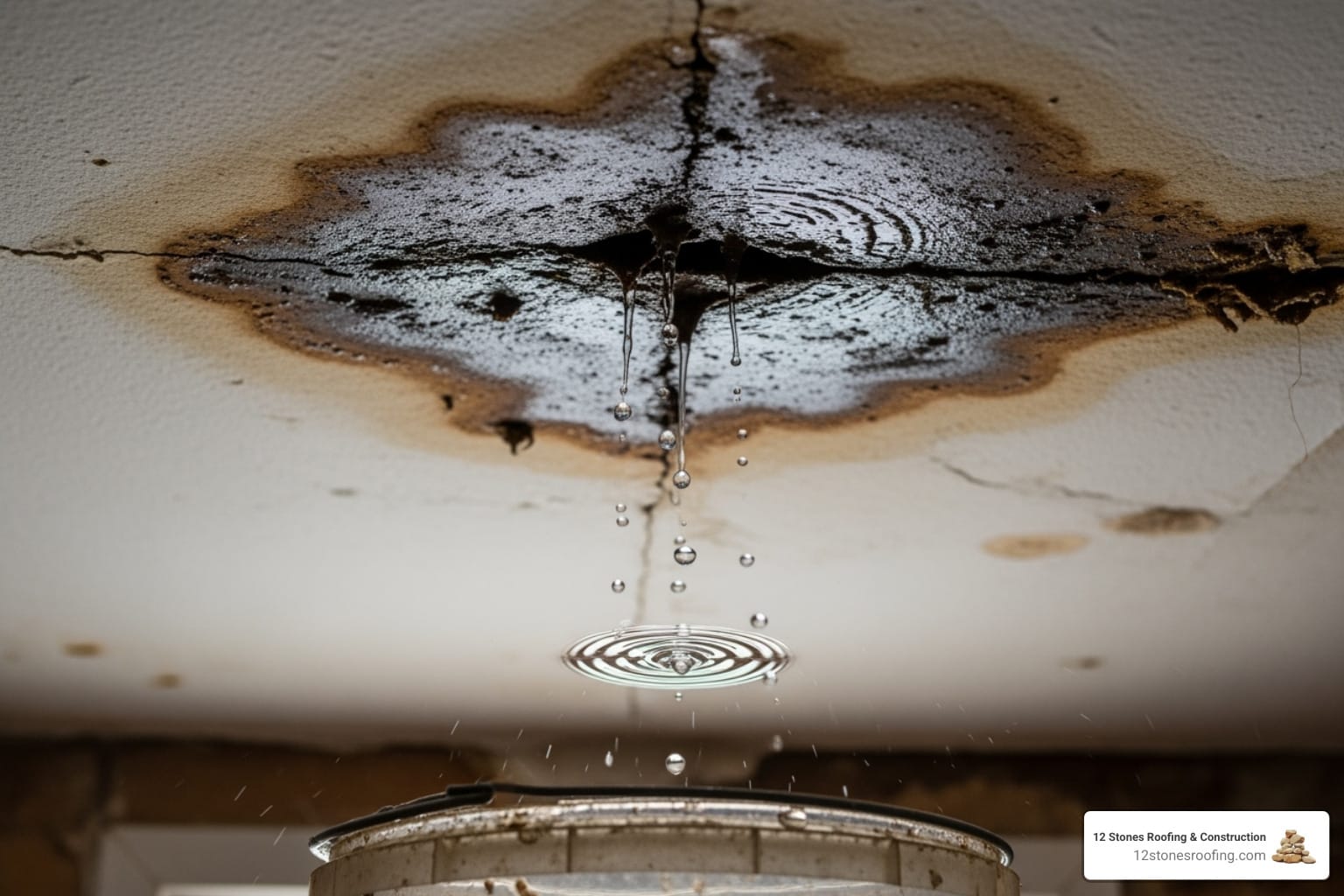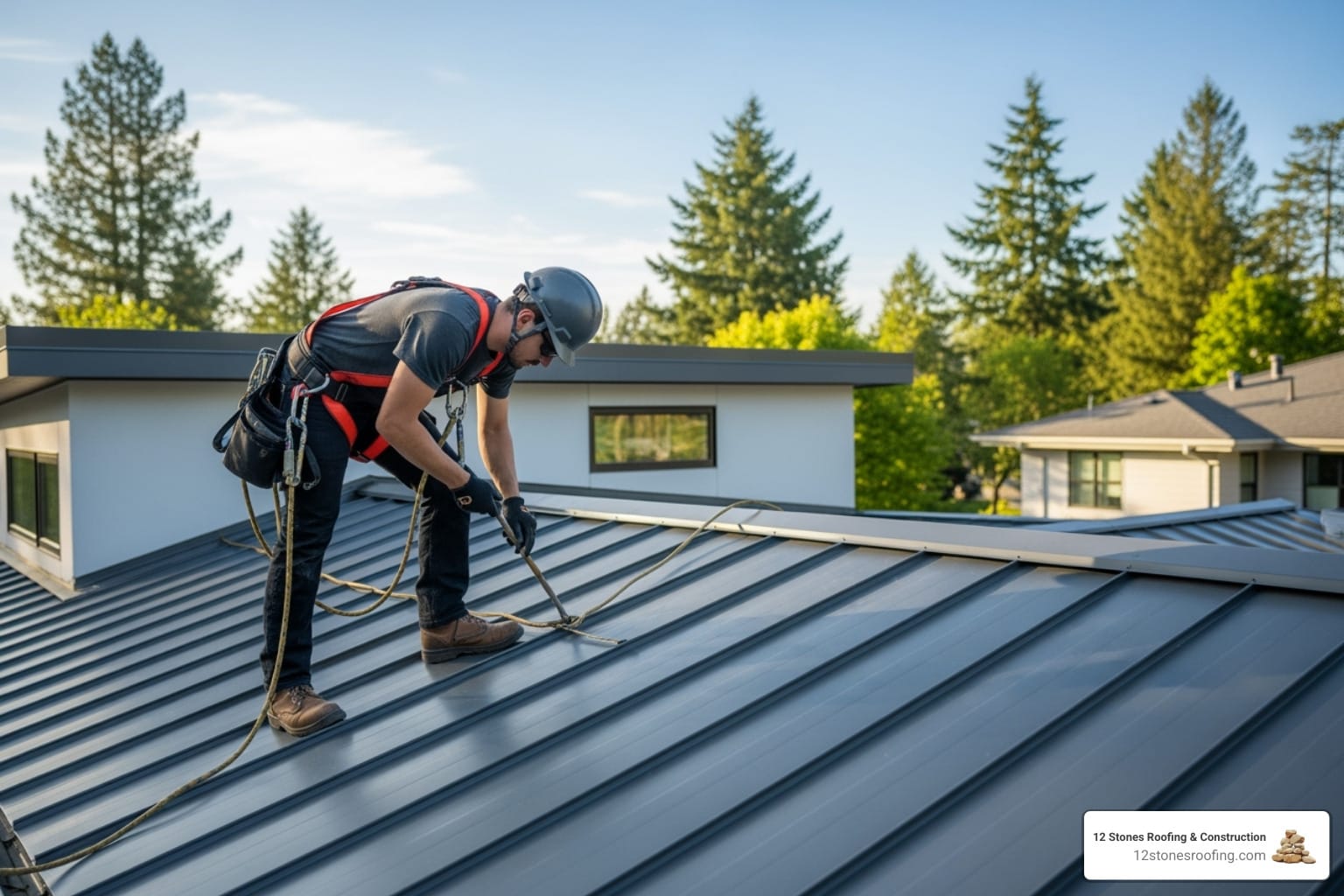Why Acting Fast on a Leaky Flat Roof Matters
A leaky flat roof repair demands immediate attention. For property owners in Pasadena, delaying action can lead to costly water damage, structural issues, and mold. Understanding your options for professional roof repair services is the first step to protecting your home or business from Texas’s harsh weather.
Quick Answer: How to Address a Leaky Flat Roof
- Find the leak source by checking for water stains, blisters, cracks, or ponding water.
- Assess the damage to determine if it’s a small patch job or requires professional help.
- Gather tools and materials including roofing sealant, membrane patches, and safety gear.
- Clean and dry the area thoroughly before applying any repair materials.
- Apply a temporary fix with roof sealant or waterproof tape for immediate protection.
- Schedule permanent repairs within weeks to prevent the issue from spreading.
- Call a professional for widespread damage, structural concerns, or recurring leaks.
A flat roof leak doesn’t always appear directly above the water stain on your ceiling. Water can travel along joists and under membranes before dripping through, making detection tricky. Well-maintained flat roofs last 10–25 years, but neglecting small leaks can cut that lifespan in half, especially in Pasadena’s climate of intense sun and heavy storms.
The good news is that most leaks are repairable. Temporary fixes like roof tar or sealant tape can stop water intrusion for 2–3 months and cost as little as $50–$150 in materials. Permanent repairs—including membrane replacement or professional resealing—can extend your roof’s life by 5–10 years, with professional services typically ranging from $300 to $1,000+.
I’m Jason Roberts, owner of 12 Stones Roofing & Construction, and I’ve spent over a decade specializing in leaky flat roof repair for residential and commercial properties throughout the Gulf Coast region. My team and I have handled everything from emergency patches during tropical storms to complete flat roof restorations, and I’m here to guide you through the repair process.
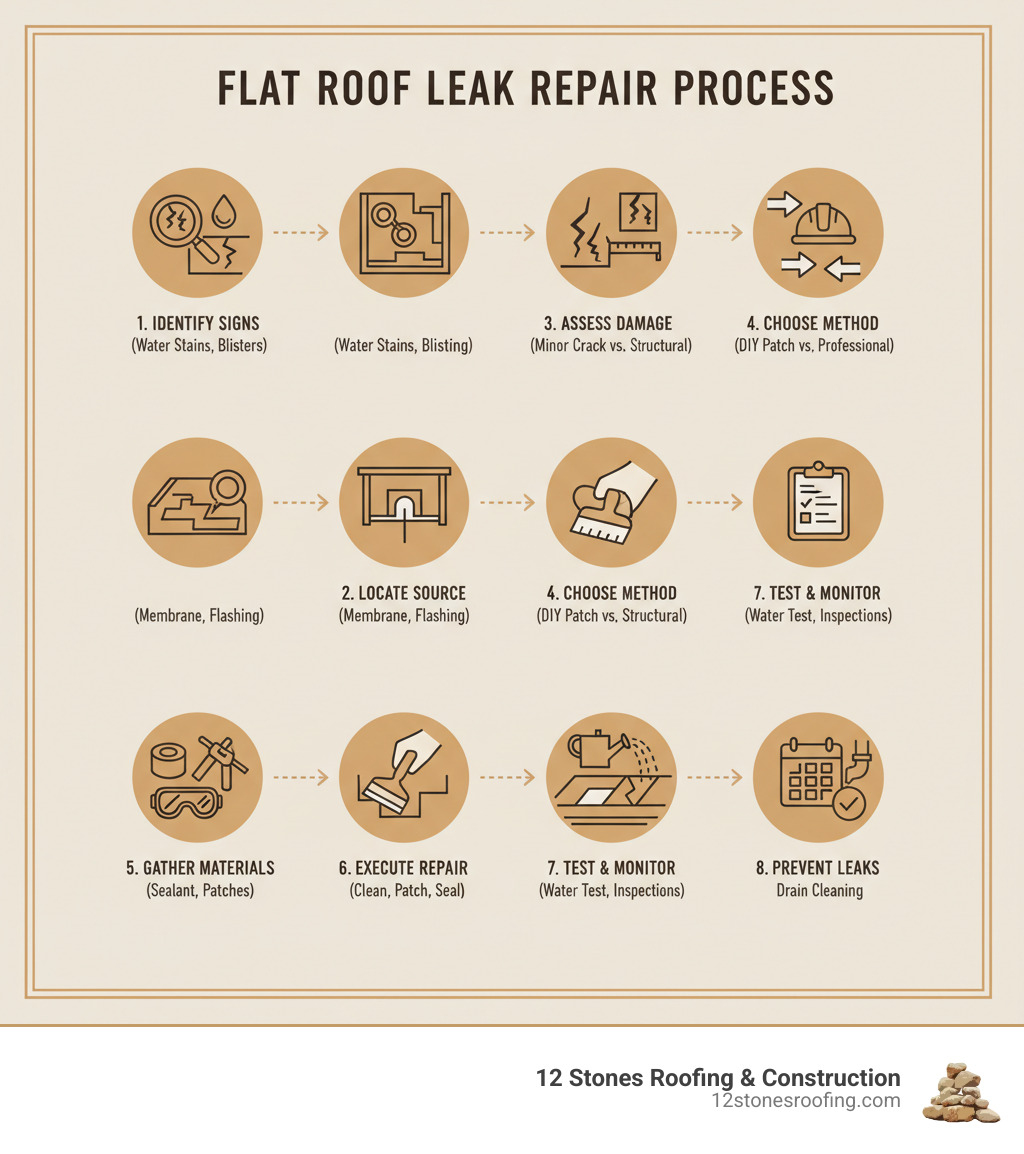
First, Find the Culprit: Signs and Causes of Flat Roof Leaks
Before any leaky flat roof repair can begin, you must play detective. Water can enter through a tiny crack and travel a surprising distance before appearing as a damp spot on your ceiling, making it tricky to pinpoint the source. While a well-maintained flat roof can last 10–25 years, Pasadena’s weather, foot traffic, or poor installation can cut that lifespan in half.
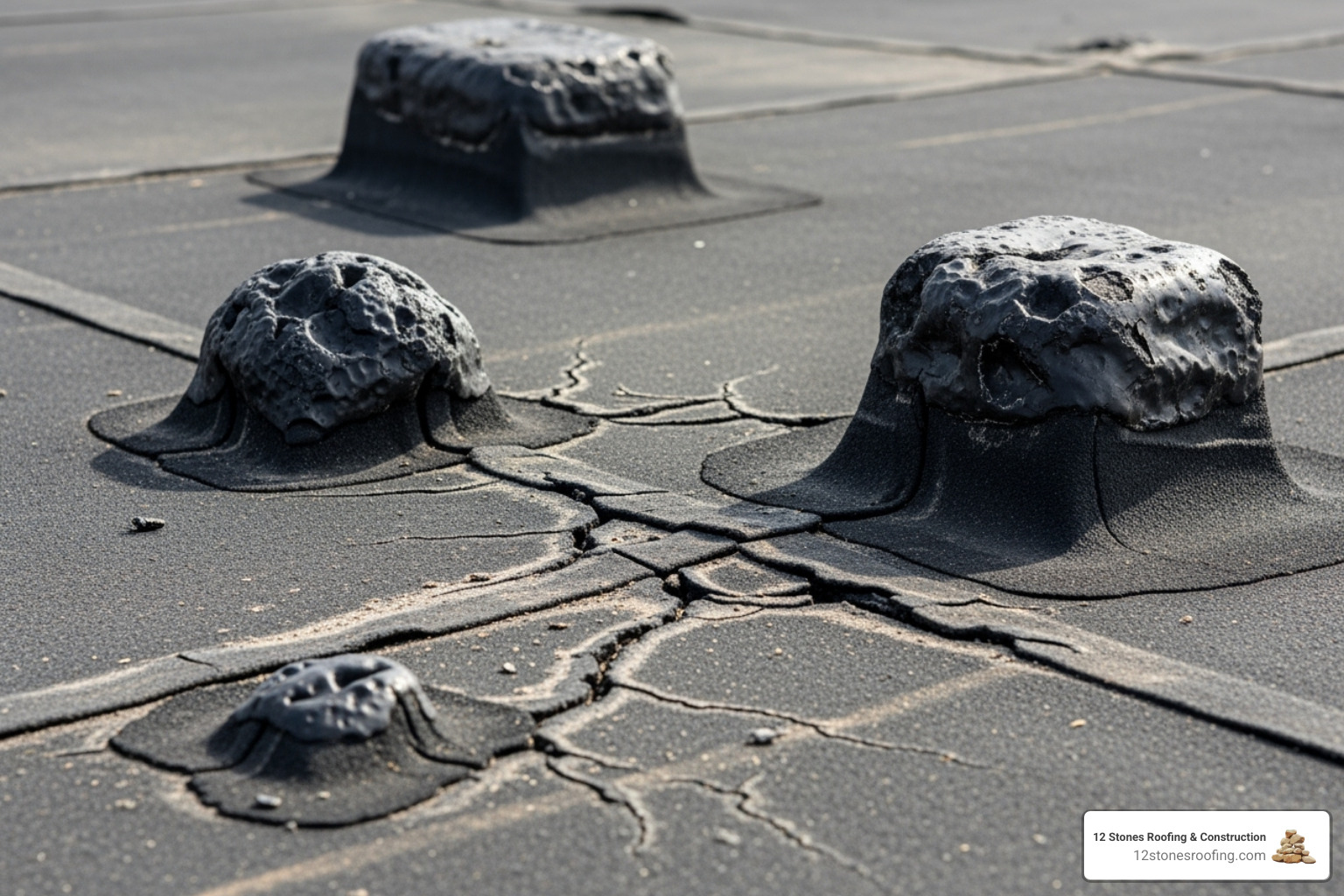
Telltale Signs Your Flat Roof is Leaking
Leaks aren’t always dramatic. Catching these early indicators can save you from major expenses down the line.
- Water stains on ceilings or walls: These discolored patches are a primary red flag, but the stain may not be directly below the leak.
- Damp or musty smells: An earthy odor signals trapped moisture inside walls or ceilings, creating a breeding ground for mold.
- Peeling paint or wallpaper: When water infiltrates drywall, paint may bubble or peel, and wallpaper can lift or discolor.
- Sagging or stained ceiling tiles: In commercial buildings, drop ceiling tiles absorb water, causing them to stain, soften, and eventually collapse.
- Blisters or cracks in the roof membrane: Blisters are trapped air or moisture pockets, and cracks are literal breaks in the roofing material. Both compromise the waterproof barrier.
- Ponding water on the roof: Puddles that remain for more than 48 hours after rain indicate poor drainage and will accelerate material breakdown, inviting leaks.
- Visible drips after rain: This is the most undeniable sign of a leak that needs immediate attention.
Why is My Flat Roof Leaking? Common Causes
Understanding the “why” helps address the root problem and prevent future issues.
- Ponding water: Poor drainage is the number one enemy. When water pools, it finds and exploits tiny imperfections in the membrane.
- UV ray degradation: Intense Texas sun causes roofing materials to dry out, become brittle, and crack, losing their waterproofing ability.
- Punctures from foot traffic or debris: HVAC technicians, maintenance crews, or fallen branches can easily puncture or abrade the roof membrane.
- Damaged flashing: Flashing seals penetrations like vents and chimneys. When it fails, water bypasses the main waterproof layer.
- Separated seams or membrane shrinkage: Over time, seams between roofing sheets can separate due to material shrinkage or adhesive failure, creating entry points for water.
- Clogged drains and gutters: When drains back up, water ponds on the roof and finds its way through any weakness.
- Age-related wear and tear: All roofing materials degrade over time, losing flexibility and becoming prone to cracks and blisters.
DIY Fix or Call a Pro? Weighing Your Repair Options
Once you’ve found a leak, you must decide: can you handle this leaky flat roof repair yourself, or is it time for a professional? The choice balances cost, skill, and the severity of the damage. A small puncture is a simple DIY patch, but widespread membrane failure requires an expert.
Minor leaks can often be patched by a handy homeowner for $50–$150 in materials. However, extensive damage, structural concerns, or complex flashing repairs warrant professional attention. Professional repairs typically range from $300 to over $1,000, depending on the damage and materials.
The Lifespan and Cost of a Leaky Flat Roof Repair
A temporary patch is an emergency stopgap, while a permanent repair is a long-term solution. Temporary patches using roofing sealant or tape can halt water intrusion for a few weeks to a few months and cost $50–$150. They are ideal for small punctures or buying time. Permanent repairs, performed by professionals, integrate with the roof system and can extend its life by 5–10 years or more. The investment is higher—$300 to $1,000+—but proactive repairs can prevent 80% of major roof failures.
| Feature | Temporary DIY Fixes | Permanent Professional Repairs |
|---|---|---|
| Cost | Lower ($50–$150 in materials) | Higher ($300–$1,000+ depending on damage extent) |
| Lifespan | Weeks to months (typically 2–3 months max) | Years (5–10+ years with quality materials and expert installation) |
| Skill Level | Basic DIY competence with safety awareness | Expert knowledge of roofing systems, specialized tools, safety training |
| Best For | Emergency water control, very minor leaks, buying time | Significant damage, recurring leaks, structural issues, warranty preservation |
When to Call for Professional Help
While DIY is empowering, some situations demand a professional for your safety and your property’s protection.
- Widespread or recurring leaks: If leaks appear in multiple spots or the same one returns, it indicates a systemic problem that a simple patch can’t solve.
- Structural sagging or damage: Any visible sagging or soft spots in the roof deck means water has compromised the support structure, posing a collapse risk.
- Flashing or seam failures: These critical areas require specialized tools and expertise to create a durable, watertight seal. Improper repairs often fail.
- Safety concerns: If you’re uncomfortable with heights, the roof is unstable, or electrical components are nearby, leave it to trained professionals with proper safety gear.
- Warranty considerations: DIY repairs can void manufacturer warranties. Professional contractors often provide workmanship warranties, offering you peace of mind.
For urgent needs in Pasadena, TX, our team at 12 Stones Roofing & Construction has decades of experience with Gulf Coast climate challenges. Don’t let a small drip turn into a disaster. Contact 12 Stones Roofing & Construction in Pasadena for reliable service, or call us at (832) 648-4375 for immediate assistance.
A Homeowner’s Guide to Leaky Flat Roof Repair
If you’ve identified a minor, accessible leak and feel confident tackling a DIY leaky flat roof repair, this guide is for you. Remember: safety is always the top priority.

Essential Safety Precautions
Before you climb, review these critical safety rules:
- Use a sturdy ladder. Place it on level ground and extend it at least three feet above the roofline.
- Wear proper gear. Non-slip shoes provide essential traction, and gloves protect your hands.
- Work in good weather. Never attempt roof work in wet or windy conditions.
- Never work alone. Have someone nearby who can assist in an emergency.
Your DIY Toolkit: Tools and Materials
Gather everything before you start to avoid multiple trips up and down the ladder.
- Tools: Utility knife, trowel, stiff brush, and a caulking gun.
- Sealant: Choose a roofing sealant specifically compatible with your roof type (EPDM, TPO, Modified Bitumen, etc.). For emergency repairs, a product like Henry 208 Wet Patch can stop leaks instantly, even on wet surfaces. It’s available at stores like Home Depot.
- Reinforcement: Fiberglass mesh or a membrane patch kit.
- Safety Gear: Gloves and safety glasses.
Step-by-Step: How to Patch a Minor Flat Roof Leak
Take your time with each step to ensure a lasting repair.
Step 1: Clean the Area. Use a stiff brush to remove all loose debris, dirt, and standing water. The sealant needs a clean surface to bond.
Step 2: Dry the Surface. Most sealants require a completely dry surface. Wait for a sunny day or use a heat gun carefully. The exception is a wet-patch product designed for damp conditions.
Step 3: Cut Away Damaged Material. Carefully cut an ‘X’ into any blisters to release trapped air or moisture. Trim away any loose or deteriorated membrane down to a solid base.
Step 4: Apply First Layer of Roofing Cement. Using a trowel, spread a generous layer of sealant over the damaged area, extending it at least six inches beyond the damage.
Step 5: Embed Fiberglass Mesh. Press a piece of fiberglass mesh or a membrane patch firmly into the wet cement, smoothing out any air bubbles.
Step 6: Apply Your Second Coat. Cover the mesh completely with another layer of sealant. Feather the edges to blend them smoothly with the surrounding roof.
Step 7: Allow Proper Curing Time. Follow the manufacturer’s instructions for curing, which can take 24 hours or more. Avoid walking on the patch during this time.
Step 8: Test Your Work. Once cured, gently hose down the area and check inside for any signs of water. If it’s dry, you’ve successfully completed a leaky flat roof repair!
If you feel unsure at any point, don’t hesitate to call for backup. For expert assistance, contact 12 Stones Roofing & Construction or call (832) 648-4375.
Beyond the Patch: How to Prevent Future Flat Roof Leaks
A successful leaky flat roof repair is a great start, but proactive maintenance is the best defense against future leaks. Regular inspections and cleaning can extend your roof’s lifespan by years, saving you from recurring headaches and costly replacements. Research shows that biannual checks can prevent up to 80% of flat roof leaks.
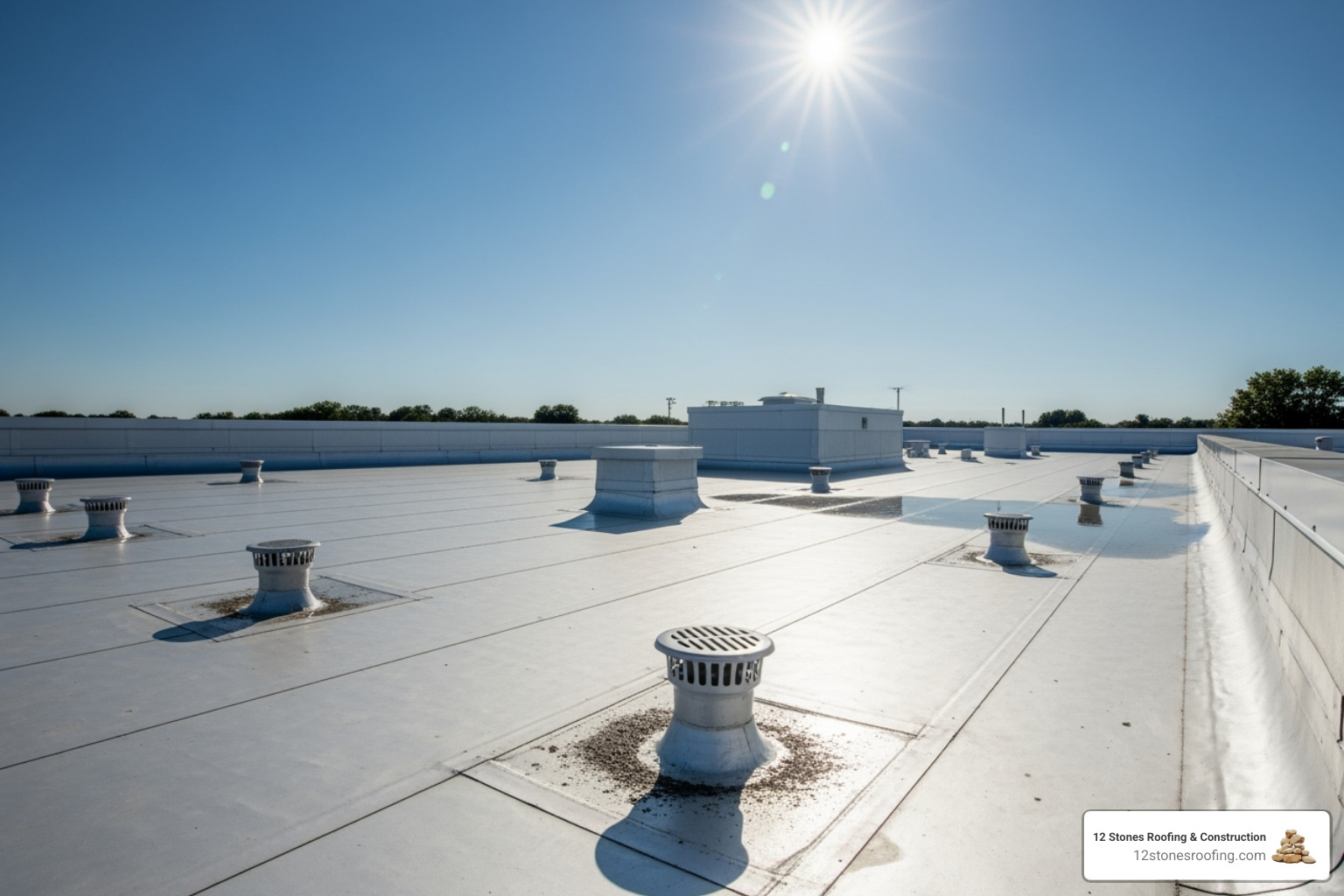
The Importance of Regular Maintenance
We recommend inspecting your roof twice a year (spring and fall) and after major storms. A consistent maintenance routine is a small investment that prevents major problems.
- Inspect for Damage: Look for new cracks, blisters, separated seams, or areas of ponding water.
- Remove Debris: Regularly sweep away leaves, branches, and dirt. Trapped debris holds moisture against the roof, which accelerates wear.
- Clear Drains and Gutters: Clogged drains are a primary cause of ponding water. Clear them at least twice a year to ensure proper drainage.
- Trim Overhanging Branches: Keep tree limbs at least six feet from your roof to prevent scraping and reduce the risk of puncture from falling branches.
- Reseal Edges and Penetrations: The sealant around vents, pipes, and skylights can degrade over time. Inspect these areas and reseal any cracks or gaps promptly.
To stay organized, use our comprehensive roof maintenance checklist for a practical, step-by-step guide.
Scheduling a Professional Roof Inspection
While DIY inspections are valuable, an annual professional inspection provides an expert eye that can spot subtle issues you might miss, such as early membrane fatigue or hidden moisture damage. A professional assessment is especially crucial after major storms in the Pasadena area, as high winds and hail can cause underlying damage that leads to future leaks.
Catching these issues early can extend your roof’s life by 5 to 10 years and save you from unexpected, costly repairs. For peace of mind and expert care, contact us at 12 Stones Roofing & Construction or call (832) 648-4375 to schedule your professional inspection today.
Frequently Asked Questions about Flat Roof Leaks
Here are the questions we hear most often about leaky flat roof repair, with straightforward answers from our decades of experience.
What is the fastest way to stop a flat roof from leaking?
The fastest way to stop a flat roof leak is to apply a roofing sealant or waterproof tape designed for emergency patches. Products like Henry 208 Wet Patch can be applied even to damp surfaces to stop water intrusion instantly. This temporary fix prevents further interior damage while you schedule a permanent leaky flat roof repair.
How much does it cost to repair a leak in a flat roof?
The cost depends on the severity of the leak. For a minor DIY patch, materials typically cost between $50 and $150. Professional repairs for more complex issues generally range from $300 to $1,000 or more. The final price is influenced by the extent of the damage, accessibility, and roofing material type. A professional assessment is the best way to get an accurate quote.
Can I repair a flat roof leak myself?
Yes, minor and accessible flat roof leaks can often be repaired by a homeowner with the right tools, materials, and safety precautions. Small punctures or isolated cracks are typically manageable DIY projects.
However, you should always call a professional for large areas of damage, recurring leaks, structural issues like sagging, or complex flashing and seam failures. Attempting a repair beyond your skill level can create more extensive damage and increase the final cost. If you are ever in doubt, call us at (832) 648-4375 for honest advice.
Conclusion: Secure Your Roof, Protect Your Home
Taking swift action on a leaky flat roof repair is about protecting your investment. A small drip can quickly escalate into major water damage, mold, and structural issues. The saying “a stitch in time saves nine” is never more true than with a roof leak.
We’ve covered how to spot the signs of a leak, understand its causes, and weigh your repair options. A temporary fix can buy you time, but the key to a healthy roof is a combination of regular maintenance and knowing when to call in the experts. A well-maintained flat roof can last 10–25 years, while a neglected one may fail in half that time.
For expert leaky flat roof repair and maintenance in Pasadena, TX, and the Gulf Coast region, trust the team at 12 Stones Roofing & Construction. We’ve spent over a decade protecting properties like yours from Texas weather. Our commitment is to quality craftsmanship and transparent service you can count on.
Don’t let a small leak become a major disaster. Whether you need an emergency patch, a thorough inspection, or a complete restoration, we’re here to help. Contact us today or call us at (832) 648-4375 for a free, no-obligation inspection. Let’s work together to secure your roof and protect your peace of mind.



